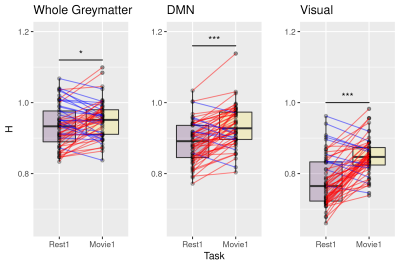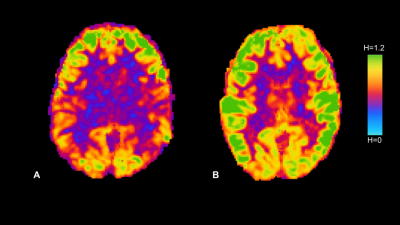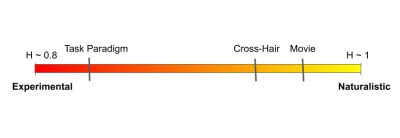2708
Fractal-Based Analysis of Movie Watching vs. Eyes-Open Resting State Reveals Widespread Differences in fMRI Signal Complexity1University of British Columbia, Vancouver, BC, Canada
Synopsis
Previous studies of functional magnetic resonance imaging (fMRI) have found that the ‘resting-state’ is more fractal than task performance. Investigating the behaviour of brain signals under naturalistic conditions, we performed fractal analysis of 7T fMRI data (n=55) under movie-watching (Movie; 10mins) and eyes-open with fixation-cross (Rest; 10mins) conditions. Compared to Rest, Movie, the more natural stimulus, showed greater fractal scaling in all three regions analyzed: whole-brain greymatter (adj_p.=0.014, Cohen’s_D=0.34), default mode network (adj_p.=2.55x10-8, Cohen’s_D=0.90), and visual network (adj_p.=6.44x10-10, Cohen’s_D=1.05), reflecting the endogenous scale-invariant state of the brain.
Introduction
Fractal analysis evaluates the degree of scale-invariance in an irregular signal; one which may at first appear random. A more fractal process has no dominant time-scale or frequency, has long-term memory, and despite appearances, is predictable1. Through quantifying this complexity in a single parameter (the Hurst exponent (H)), fractal analysis demonstrated the intrinsic fractal dynamics of the brain at all levels: neurotransmitter release2, local field potentials3, electroencephalography4, and functional magnetic resonance imaging (fMRI)5–7. Thus the brain is fractal by nature: its true endogenous state has prominent scale-invariance and long-range correlations6,7. However, it has recently been proposed that the conventional resting-state fMRI condition where subjects fixate on a cross-hair may not best capture the endogenous dynamics of the brain. Rather, more naturalistic or ecologically valid conditions, such as movie-watching, may better reflect the ongoing innate brain activity that underlies daily life, and therefore daily cognitive processes and symptoms8. In this study, we set out to measure whether watching either a fixed cross-hair (i.e., resting-state; ‘rest’), or a dynamic audiovisual movie (‘movie-watching’), exhibited a higher H value at the whole-brain level, and also within the default mode network (DMN) and visual network. We hypothesized that H would be significantly higher during movie-watching relative to rest in all three parcellations, indicating a more fractal signal.Methods
We applied one of the best performing fractal analysis techniques, Welch’s method9, on resting-state and movie-watching fMRI (7 Tesla, TR=1s) data of 55 subjects (ages=22-35; mean 29.33 years; 20M/35F) from the Human Connectome Project database (https://www.humanconnectome.org/). Each subject was scanned with eyes fixed on a cross-hair (~10mins), and viewing a short film (~10mins). H was compared between the two paradigms in three regions-of-interest: whole-brain greymatter, a combined visual network, and the default mode network (DMN) using a paired Student’s T-test. Multiple-comparisons were corrected for using Holm’s Step-Down Procedure.Results
Movie-watching resulted in higher H values and more persistent fractal phenomena (greater scale-invariance) in whole-brain greymatter, visual network, and DMN, as compared to the same subjects at rest (see Table 1, and Figures 1 and 2). The effect size (Cohen’s D) of these differences was found to be small in the greymatter, but large in the DMN and visual network (Table 1).Discussion
The Hurst exponent is a measure of long memory dependence in brain signals, where higher values, as seen during movie-watching, reflect greater temporal redundancy and autocorrelation10. Thus, past dynamics more strongly mediate future processing when viewing a movie and the brain is better able to predict and update brain states throughout perception. Movie-watching may therefore reflect the endogenous state that the brain has evolved to maintain because, like real-life experiences, it requires the continuous integration of sensory and higher-order processing. These data suggest that such dynamic processes depend on long-memory correlations in the brain signal, as shown by more persistent fractal behaviour.Changes in brain dynamics can be represented on an experimental-naturalistic spectrum, with experimental task conditions on one end, and the brain’s more natural state on the other (Figure 3). In fMRI, experimental tasks are typically measured through discrete and unnatural paradigms that are non-taxing and artificially repetitive. Task activation has been consistently found to reduce H values from the cross-hair condition6,7. Thus the shift in H from the “Cross-Hair” condition towards the “Naturalistic” end of the spectrum, rather than “Experimental”, during movie-watching is aligned with previous findings, and suggests that naturalistic perception is driven by a more time-invariant mechanism than both conventional resting- and task-based paradigms.
However, the estimated effect size in the greymatter is notably small, with an increase in H values observed in 32 subjects but a decrease in 23 (see colored lines in Figure 1). These mixed results suggest that there is more scale-free behaviour overall in the greymatter; however, there is likely a combination of increasing and decreasing H values that is network-specific. This is demonstrated in the larger effect sizes observed in the visual network and DMN, where 44/55 and 46/55 subjects reported increased H values, respectively. Compared to viewing a stationary cross-hair, it can be concluded that watching a continuous stream of audiovisual information induces significantly stronger long-memory behaviour in these regions.
Conclusion
The value of this finding is two-fold, in that it: 1) highlights the ability of fractal analysis to precisely differentiate brain dynamics; and 2) provides supportive evidence for the use of movie-watching to best capture the brain’s true endogenous fractal state. By accurately quantifying the innate dynamics of the brain signal, we have laid a foundation for future efforts to use and refine this technique to generate subject- and network-specific endogenous reference values in individuals. This may be valuable in experimental and clinical settings, where deviations in H from this baseline value might predict enhanced or impaired network functioning.Acknowledgements
The authors and this study were financially supported by the British Columbia Children’s Hospital Research Institute (Establishment Award and Salaries).References
1. Eke, A., Herman, P., Kocsis, L. & Kozak, L. R. Fractal characterization of complexity in temporal physiological signals. Physiol. Meas. 23, R1–R38 (2002).
2. Lowen, S. B., Cash, S. S., Poo, M. & Teich, M. C. Quantal Neurotransmitter Secretion Rate Exhibits Fractal Behavior. J. Neurosci. 17, 5666–5677 (1997).
3. Bédard, C. & Destexhe, A. Macroscopic Models of Local Field Potentials and the Apparent 1/f Noise in Brain Activity. Biophys. J. 96, 2589–2603 (2009).
4. Bullmore, E. T. et al. Fractal analysis of electroencephalographic signals intracerebrally recorded during 35 epileptic seizures: evaluation of a new method for synoptic visualisation of ictal events. Electroencephalogr. Clin. Neurophysiol. 91, 337–345 (1994).
5. Maxim, V. et al. Fractional Gaussian noise, functional MRI and Alzheimer’s disease. NeuroImage 25, 141–158 (2005).
6. He, B. J. Scale-Free Properties of the Functional Magnetic Resonance Imaging Signal during Rest and Task. J. Neurosci. 31, 13786–13795 (2011).
7. P, C., P, A. & Bj, H. Interplay between functional connectivity and scale-free dynamics in intrinsic fMRI networks. Neuroimage 95, 248–263 (2014).
8. Meer, J. N. van der, Breakspear, M., Chang, L. J., Sonkusare, S. & Cocchi, L. Movie viewing elicits rich and reliable brain state dynamics. Nat. Commun. 11, 5004 (2020).
9. Rubin, D., Fekete, T. & Mujica-Parodi, L. R. Optimizing complexity measures for FMRI data: algorithm, artifact, and sensitivity. PloS One 8, e63448 (2013).
10. Eke, A. et al. Physiological time series: distinguishing fractal noises from motions. Pflüg. Arch. 439, 403–415 (2000).
Figures



